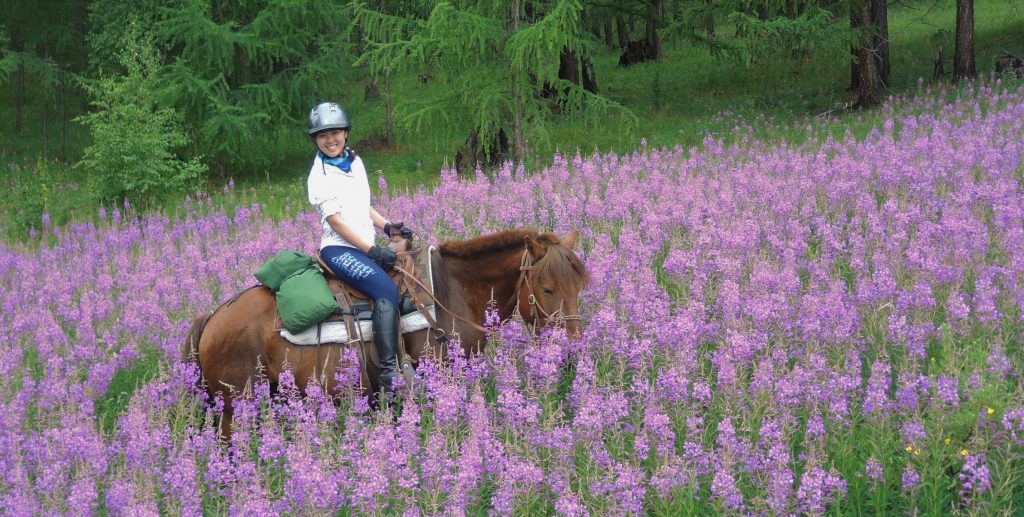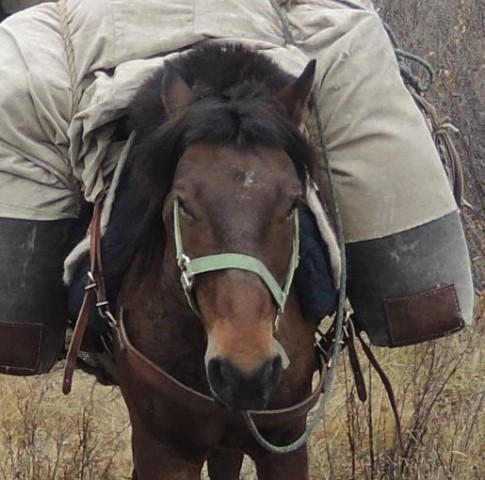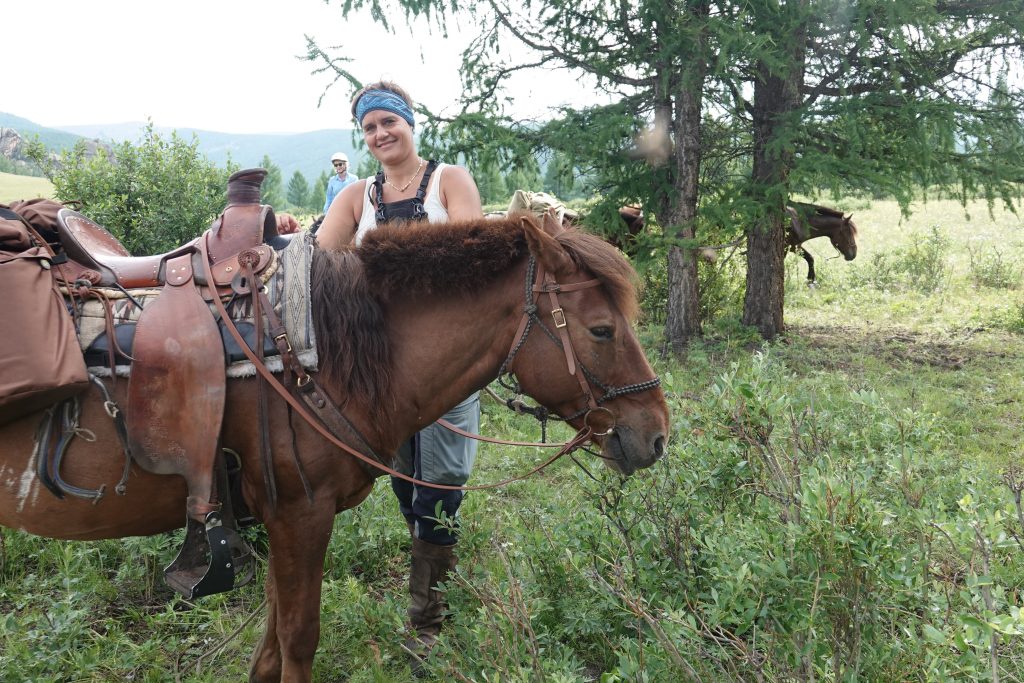No products in the cart.
Horses for Riding Holidays in Mongolia
Mongolian Horses – Great Saddle and Pack Horses for Horse Trekking Holidays
The Stone Horse herd is a team of great horses for riding holidays in Mongolia. Our Mongolian horses make it possible for our guests and us to experience the great Mongolian landscapes with ease, to move across the steppes, over mountain passes and through rivers. These great horses enable us to take along everything we need for good meals, to relax in camp and have a safe and comfortable wilderness experience.
We owe our horses a big thank you and we do our best to take good care of them all year round! Introducing them as the individuals they are, both in character and conformation, will also give a bit of an insight into the great Mongolian horse breed – horses of amazing physical stamina as well as mental aptitude. And quite a sense of humor, too.
Meet our Equine Team – the Stone Horses!
The order of introduction here is random, regardless of rank or seniority on the job, age, or specialization.
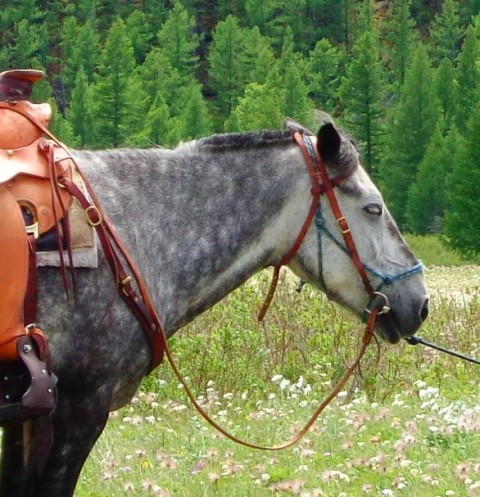 “The Blue Roan” – “Khukh Buraal”. Let’s start with the “Blue Roan”, and that is his name in Mongolian language. In Mongolia, horses are commonly named for their color and other individual characteristics they may display. Our Blue Roan is a horse with all-round skills and a relaxed attitude. Most times, he is on the trip as a packhorse. He does a great job but likes to do it without being pushed or pulled. So he usually runs free, following at his own discretion which allows him to hang back a bit or take little deviations for some snacks of good grass.
“The Blue Roan” – “Khukh Buraal”. Let’s start with the “Blue Roan”, and that is his name in Mongolian language. In Mongolia, horses are commonly named for their color and other individual characteristics they may display. Our Blue Roan is a horse with all-round skills and a relaxed attitude. Most times, he is on the trip as a packhorse. He does a great job but likes to do it without being pushed or pulled. So he usually runs free, following at his own discretion which allows him to hang back a bit or take little deviations for some snacks of good grass.
He runs with his best friend in the herd, the little pack horse named “Little Kheer”. They do wait for each other and don’t like to be separated. The Blue Roan is a fairly big horse for a Mongolian horse and he can move nicely when he wants and when the rider asks him with some assertion to do so.
“Little Kheer” is named for his rather small size and his brown (kheer) color. He is a pack horse and has his dedicated harness that nobody else wears. He is reliable on his job and is proud to do it – but without being pushed along! A small guy with his own strong mind, he likes to stay close to his big friend the Blue Roan. He keeps a low profile but he definitely does pull his weight in the team effort and is a trusted veteran on the trail.
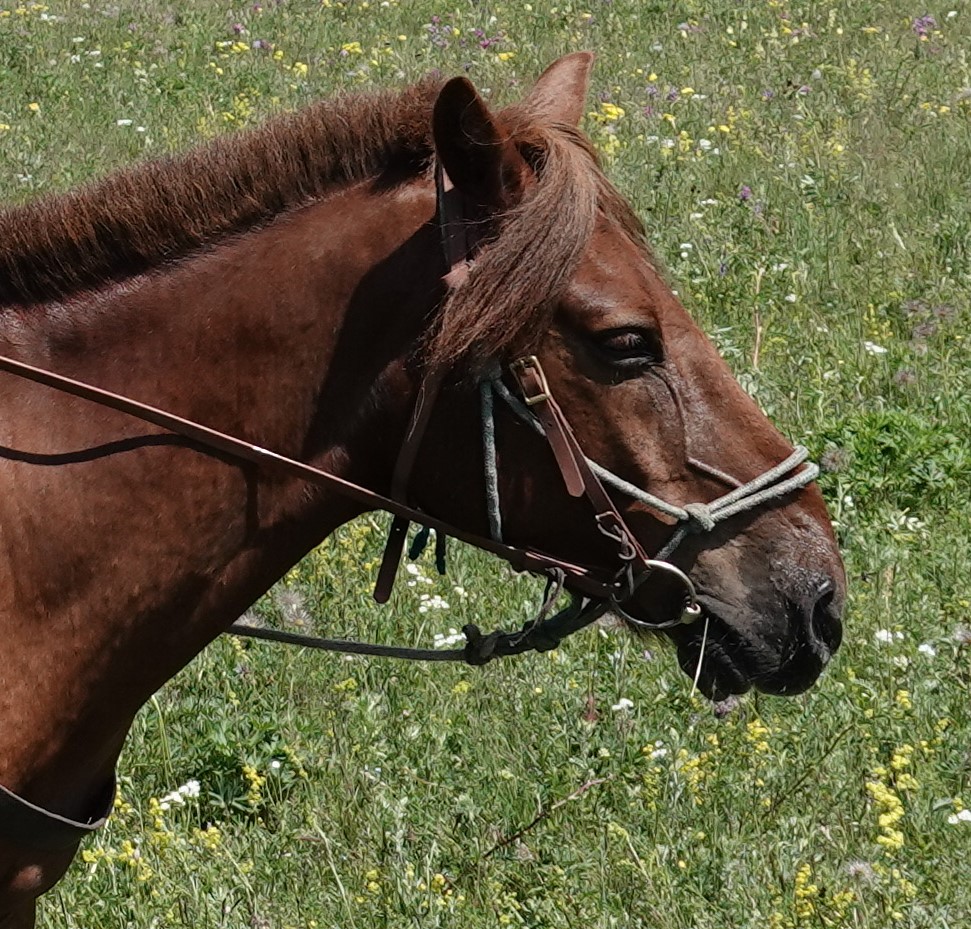 “Brownie” is of a liver chestnut color, khuren in Mongolian. He is the darling of many who have ridden him, and returning guests make reservations for Brownie. He has a great gait, is very surefooted, responsive and spirited and a joy to ride. He can be fast when asked by his rider and challenged by a team mate, but he does listen to the rider’s wishes. He is a very friendly horse in the pasture or in the corral where he comes up to us for a sniff and likes to get his ears scratched. On the trail, he doesn’t like any horses, with or without rider, close to his left rear, he’s a bit touchy about that and we should respect that. In the winter, Brownie does like his oats and can be a bit adamant about getting his fair share.
“Brownie” is of a liver chestnut color, khuren in Mongolian. He is the darling of many who have ridden him, and returning guests make reservations for Brownie. He has a great gait, is very surefooted, responsive and spirited and a joy to ride. He can be fast when asked by his rider and challenged by a team mate, but he does listen to the rider’s wishes. He is a very friendly horse in the pasture or in the corral where he comes up to us for a sniff and likes to get his ears scratched. On the trail, he doesn’t like any horses, with or without rider, close to his left rear, he’s a bit touchy about that and we should respect that. In the winter, Brownie does like his oats and can be a bit adamant about getting his fair share.
“New Brownie”, or “Shine Khuren” came to Stone Horse with four other equines after they had completed a trek of several months with an international group of riders and were looking for a good home and herd to join. He has become a popular saddle horse for his easy going ways. He can be a bit fuzzy about having his head touched to put the headstall on. He proofed to be an excellent collaborator for a photographer who joined one of our 2019 treks, showing good understanding for the requirements of shooting stills and video on the trail.
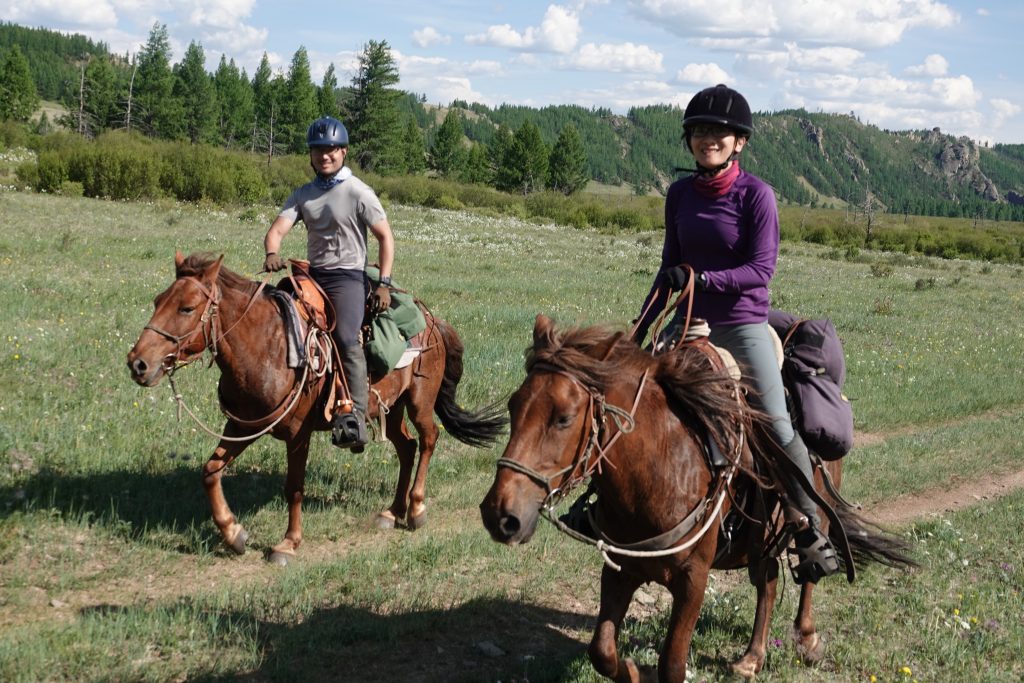
Therapeutic Horse Riding in Mongolia
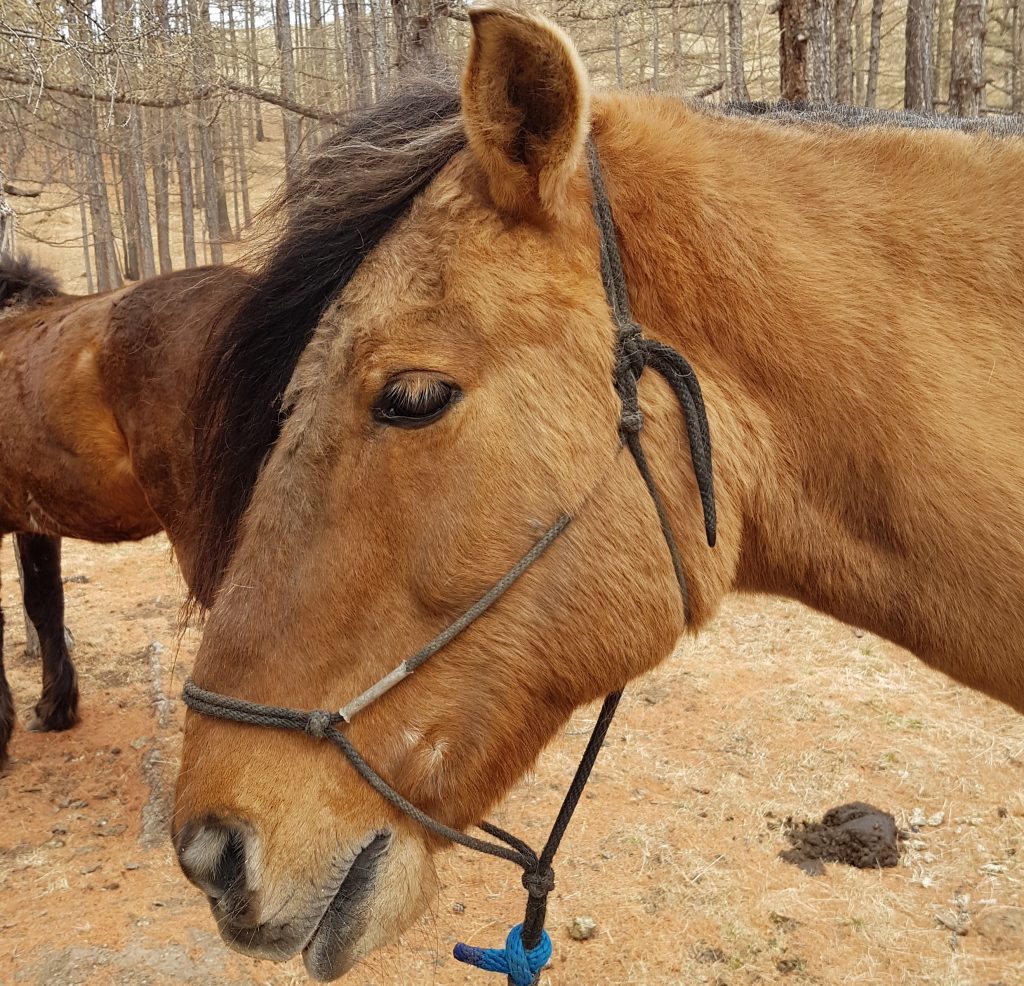 “Rocket”, Ulaanbaatar and Alag came to us as a team, having worked part-time in therapeutic riding before. “Rocket” is our biggest horse, and one of the old timers, in his thirties now and still working as a pack horse. He is the only Stone Horse not pure bred Mongolian horse; one of his parents was a Russian Tomsk horse. He came to us from Batshireet District in the Northern Khentii, near the border. And he had his name for a reason… A previous owner woudl ride him on multi-day trips from the Northern forest area all the way to Ulaanbaatar city.
“Rocket”, Ulaanbaatar and Alag came to us as a team, having worked part-time in therapeutic riding before. “Rocket” is our biggest horse, and one of the old timers, in his thirties now and still working as a pack horse. He is the only Stone Horse not pure bred Mongolian horse; one of his parents was a Russian Tomsk horse. He came to us from Batshireet District in the Northern Khentii, near the border. And he had his name for a reason… A previous owner woudl ride him on multi-day trips from the Northern forest area all the way to Ulaanbaatar city.
Rocket is a “Khul”, or bay- colored horse. Being the biggest in the team, he carries the big panniers with food on the trail. He has shown great aptitude and understanding when he was used for therapeutic riding by his previous owner, safely carrying kids and adults and giving them a great experience of moving on horseback.
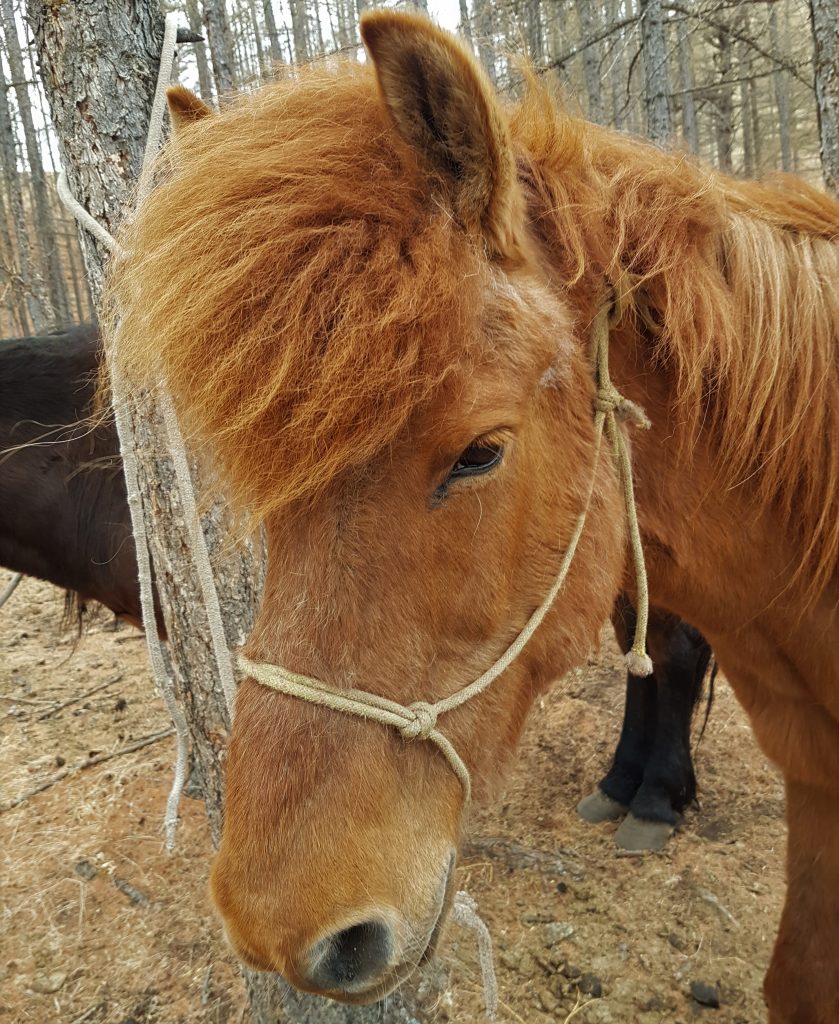 “Ulaanbaatar”, a chestnut horse, is named for his red color – Ulaanbaatar translates into “Red Hero”. He likes people and is, besides Rocket, the only horse who likes sugar, a habit usually unknown to Mongolian horses. UB (short form for Ulaanbaatar, also the city is often called UB) is very serious about his job; he carries another bigger pack – with most of the camp kitchen – and it seems he knows how important he is. UB is the dominant horse among the pack horse crowd. He acts as a bit of a disciplinarian when younger horses get out of line – he pushes them back on the trail and nips them in the butt to move along with everybody else.
“Ulaanbaatar”, a chestnut horse, is named for his red color – Ulaanbaatar translates into “Red Hero”. He likes people and is, besides Rocket, the only horse who likes sugar, a habit usually unknown to Mongolian horses. UB (short form for Ulaanbaatar, also the city is often called UB) is very serious about his job; he carries another bigger pack – with most of the camp kitchen – and it seems he knows how important he is. UB is the dominant horse among the pack horse crowd. He acts as a bit of a disciplinarian when younger horses get out of line – he pushes them back on the trail and nips them in the butt to move along with everybody else.
At times he also takes the initiative when a group of riders and horses stop to take in the view or a quick rest; UB may decide it’s time to move on and he marches ahead, taking all the pack horses with him- down the trail they know well and towards the next campsite… to call it a day. His leadership skills do have a comical side – like last year when he wanted to show everybody how to go through a REAL boggy stretch of the trail. He couldn’t wait as we assessed the situation, he just marched ahead very bravely, without hesitation – and was soon down to his ears in the mud. He came up gasping, spitting out dirt, but acted as if nothing had happened.
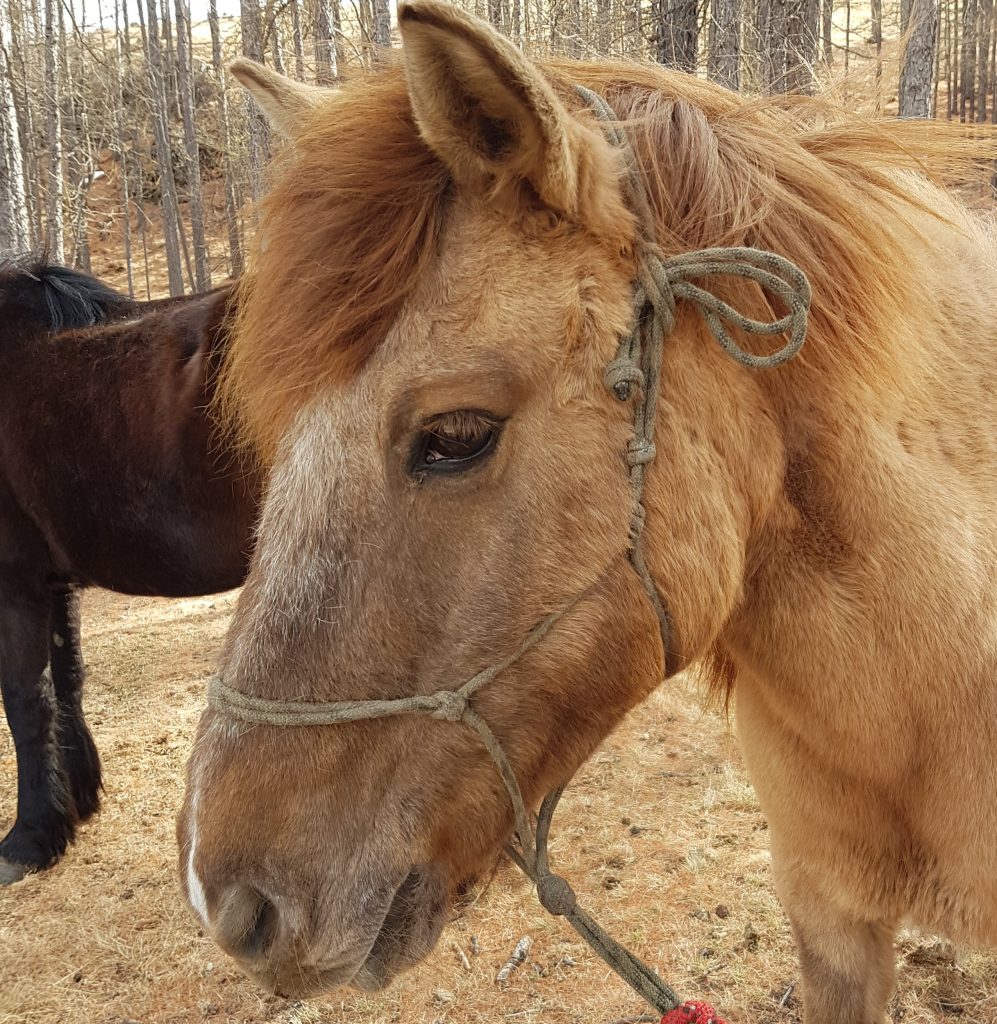 “Alag” is a light colored dun paint horse, a strong little horse that has carried riders of all levels of experience. He made it very clear one year that he does not consider himself a pack horse, and we respect that. He is a fine horse with great endurance and can run if asked for it. He is friends with big Khongor, for whom its particular important to have a friend.
“Alag” is a light colored dun paint horse, a strong little horse that has carried riders of all levels of experience. He made it very clear one year that he does not consider himself a pack horse, and we respect that. He is a fine horse with great endurance and can run if asked for it. He is friends with big Khongor, for whom its particular important to have a friend.
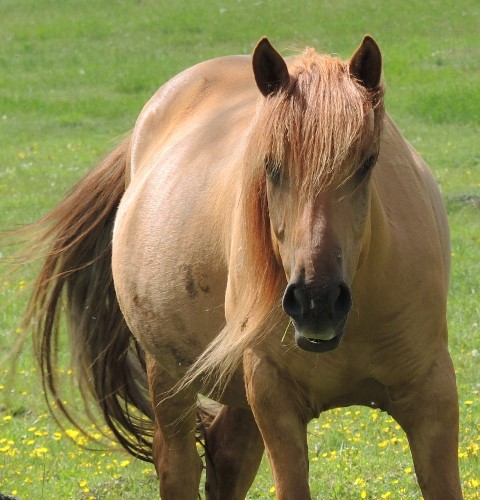 “Khongor” lives with the herd; he came to us, together with Blackie, since the owner of these two was leaving the country, we were asked to take them on. He is a beautiful horse, but after some bad experiences at a previous place he never fully regained his confidence with people. Our horsemen have ridden him and he enjoys being out with the herd and part of the action. He gets nervous when he is left alone, and has remained shy and very careful. He is very strong and has a very nice smooth gait. Khongor is the word for a honey colored horse.
“Khongor” lives with the herd; he came to us, together with Blackie, since the owner of these two was leaving the country, we were asked to take them on. He is a beautiful horse, but after some bad experiences at a previous place he never fully regained his confidence with people. Our horsemen have ridden him and he enjoys being out with the herd and part of the action. He gets nervous when he is left alone, and has remained shy and very careful. He is very strong and has a very nice smooth gait. Khongor is the word for a honey colored horse.
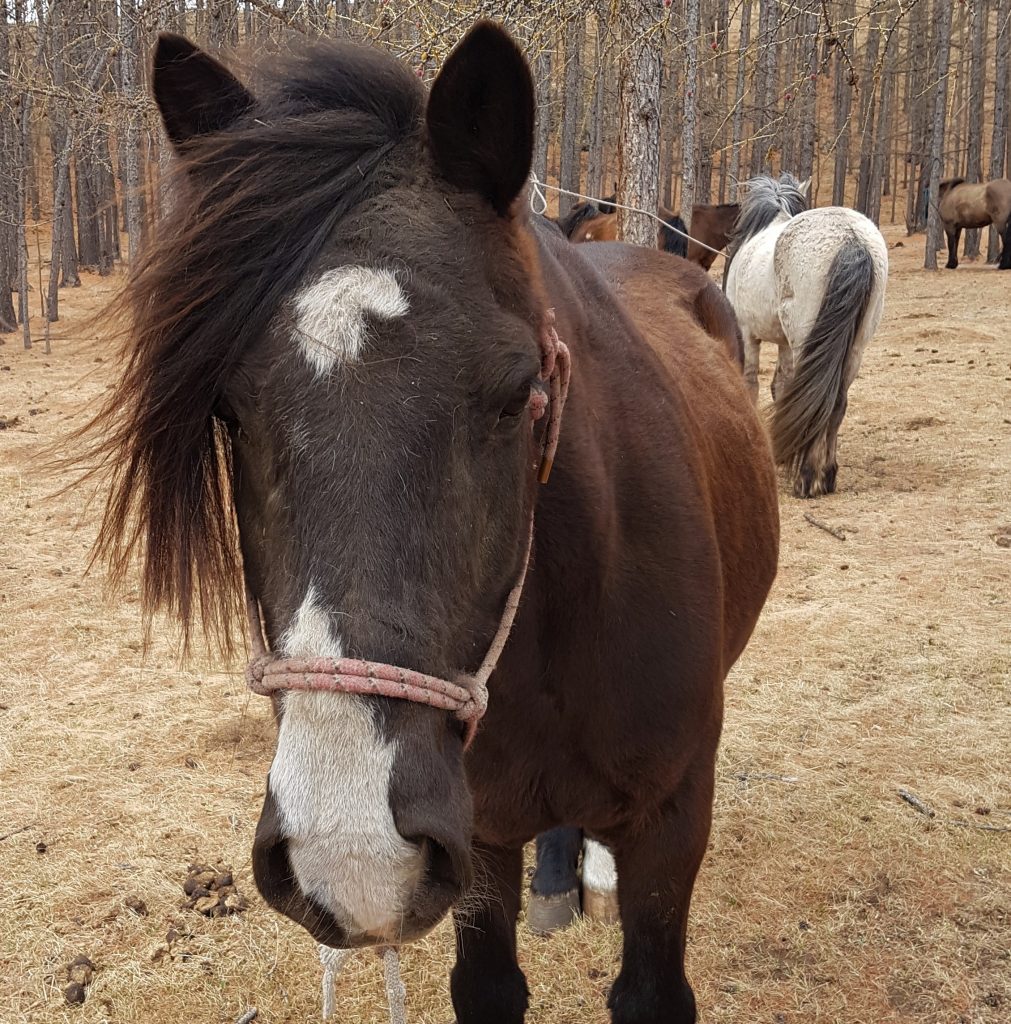 “Blackie” was all scarred and skinny when we got him, but with good care and plenty to eat he soon morphed into a barrel shaped little powerhouse. He is a real mutton withered horse with a flat back. He is a good strong horse and our team members all like to ride him because of his smooth gait and fast trot. Blackie has also been the horse of experienced guest riders. He has the distinction of once having performed a perfect summer sault in the pasture when he tried to run downhill after other horses while he was hobbled… (which he must have forgotten for a moment…) – neither he nor the saddle he was wearing had any scratch.
“Blackie” was all scarred and skinny when we got him, but with good care and plenty to eat he soon morphed into a barrel shaped little powerhouse. He is a real mutton withered horse with a flat back. He is a good strong horse and our team members all like to ride him because of his smooth gait and fast trot. Blackie has also been the horse of experienced guest riders. He has the distinction of once having performed a perfect summer sault in the pasture when he tried to run downhill after other horses while he was hobbled… (which he must have forgotten for a moment…) – neither he nor the saddle he was wearing had any scratch.
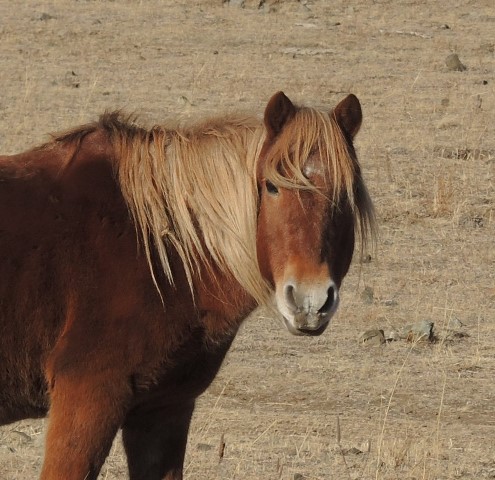 “Tsevder” is older but you wouldn’t know it when you see him running with the team, or even ahead. He has the lightest gait you can imagine, he dances along and is very smooth – and he wants to keep going… He is from Sukhbaatar province in Mongolia’s Southeast and famous for its fast horses. Tsevder was ridden by staff and experienced guest riders. He is now pretty much retired and hangs out in the valley, enjoying his privileges like bowls of oat and bran separately, outside the corral with the unruly crowd of younger guys.
“Tsevder” is older but you wouldn’t know it when you see him running with the team, or even ahead. He has the lightest gait you can imagine, he dances along and is very smooth – and he wants to keep going… He is from Sukhbaatar province in Mongolia’s Southeast and famous for its fast horses. Tsevder was ridden by staff and experienced guest riders. He is now pretty much retired and hangs out in the valley, enjoying his privileges like bowls of oat and bran separately, outside the corral with the unruly crowd of younger guys.
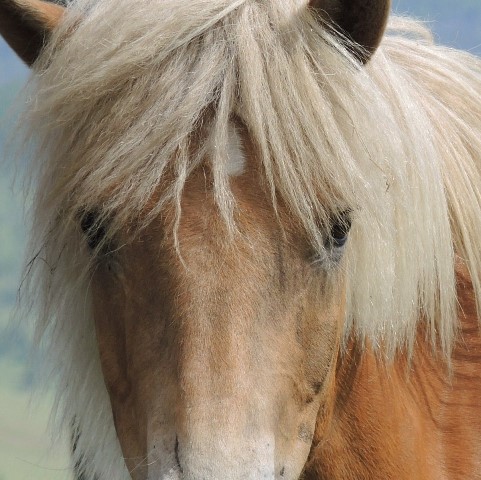 “Tseerd” is a blond chestnut and gets his name from the Mongolian word “Tseer” for the Mongolian gazelle; he is exactly that color, a beautiful light brown with lighter color at his belly and a light colored mane, very pretty. You probably have come across his portrait on our website, gleaming in the autumn sun. He is a strong little horse that has delighted many riders with his easy manners and responsiveness to the rider’s intentions. A great horse for riders of all levels. And, he has also become the favorite riding horse of returning guests who book “Tseerd” for another Stone Horse Expedition.
“Tseerd” is a blond chestnut and gets his name from the Mongolian word “Tseer” for the Mongolian gazelle; he is exactly that color, a beautiful light brown with lighter color at his belly and a light colored mane, very pretty. You probably have come across his portrait on our website, gleaming in the autumn sun. He is a strong little horse that has delighted many riders with his easy manners and responsiveness to the rider’s intentions. A great horse for riders of all levels. And, he has also become the favorite riding horse of returning guests who book “Tseerd” for another Stone Horse Expedition.
Mongolian Horses of Great Disposition – “Nomkhun” in Mongolian Language
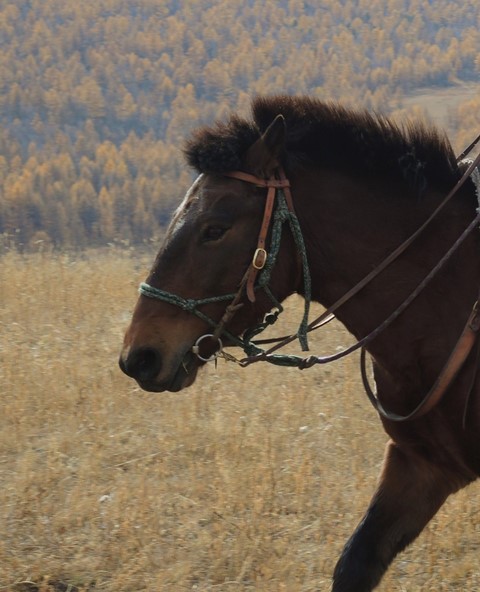
“Ben and Jerry” – these two joined Stone Horse in 2013 as youngsters that looked very much alike. Only their different hairstyles told them apart, and only Jerry has a brand. In the first months after their arrival, these two little horses stuck together and looked out for each other. They were both very easy and friendly horses – what is called “Nomkhun” in Mongolian (gentle, calm, friendly) but this doesn’t mean they can’t move; with the right riders, these two are all over the place, exploring along the trail and cantering across the steppes.They were named by two young girls who rode them in that first season.
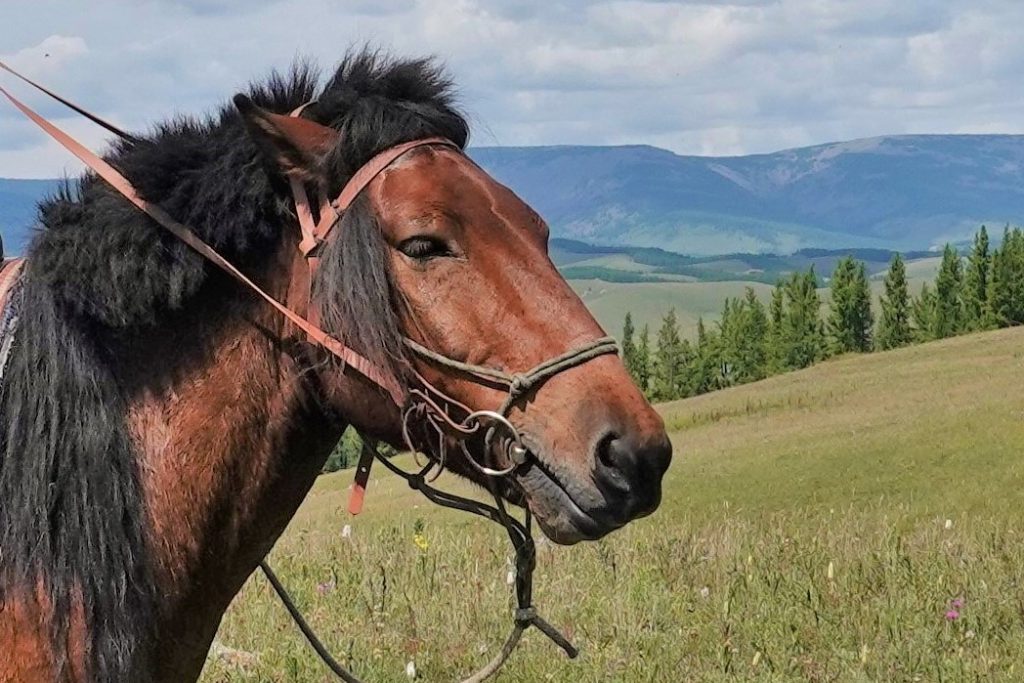
Ben turned out to be the leader of the two. He is strong and more forward than Jerry. Staff ride him sometimes. He is great under saddle, and likes to move, but mostly he is a pack horse. Jerry has become a VERY beloved saddle horse by regular riding guests, cherished for his colorful character, relaxed style and distinctive hair do. When left to his own devices, he tends to hang back. but he CAN run like any horse.
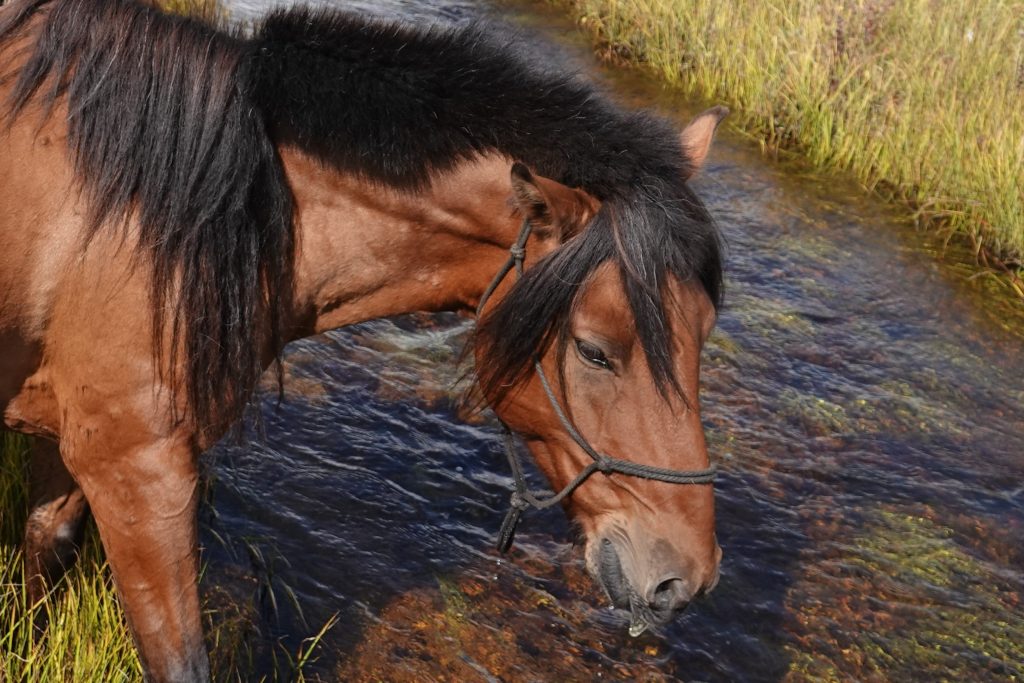
“Shar Khul and Shine Kheer” – were another set of two that arrived together at Stone Horse. “Shar Khul” translates into “light bay”, and “Shine Khul” means “New Bay”. He has changed coloration a bit and now is called “Shine Kheer”, the “New Brown”. Reliable and strong horses, these two have first been ridden by Byamba and Buyana, our wranglers. “Shar Khul” likes a cool drink on the go; when we cross rivers he likes to scoop up the clear cold water in the fast current while he makes his way across. Byambaa makes him perform all the gaits Mongolian horsemen distinguish, and “Shar Khul” can fall into a great fast and smooth trot.
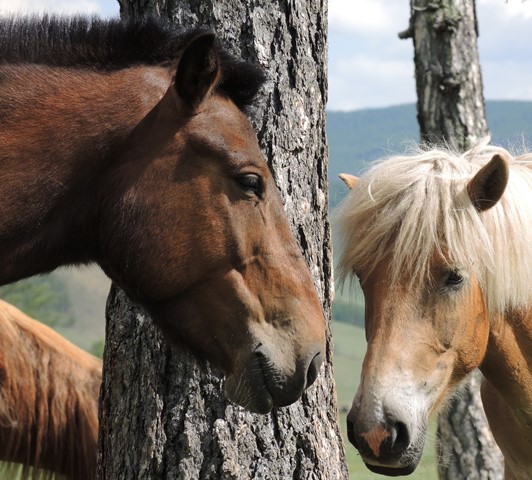
“Shine Kheer” has become a very friendly guy to both people and equine team mates, as well as another great expedition mount. He is mostly working as a pack horse nowadays though.
The two horses are from the Khan Bogd Mountain South of Ulaanbaatar, not too far from the Stone Horse staging area. In their first year with us, they decided to head back there when most of the herd was out on a trip . Yadmaa, the experienced herder looking after the Stone Horse herd when we are gone, soon tracked them down and returned them to the Darkhid Valley.
Mongolian Horses for Trekking – Smart and Great Team Players
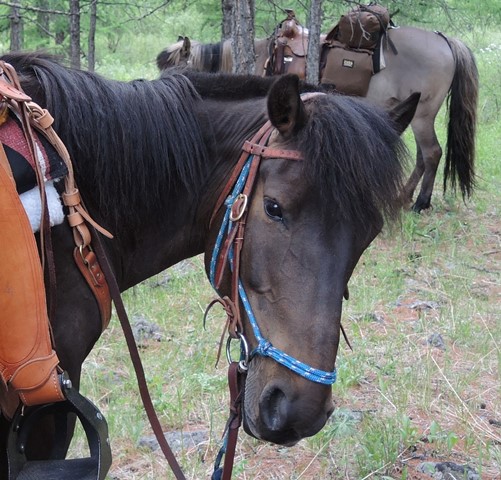
“Big and Little Dirty Face” both work as pack horses, but are good guys for riding as well. Particularly “Big Dirty Face” is popular, and also requested by repeat guests. Like many of their colleagues, they get their names from the Mongolian custom to call horses by their color. So they are both “Haltar Mor” – mor (horse) with a color pattern that does look like a “dirty face”. However, they have other distinctions as reliable pack horses, and “Big Dirty Face” is a real character. He has lots of good humor and curiosity. And, unlike any of the other Mongolian horses, he has acquired a taste for anything the riders eat and drink. This includes chocolate cookies served on the camping table, the picnic lunch, cowboy coffee and leftovers from any meal. So he is one to watch out for as he sneaks up on trail riders enjoying food and drink.
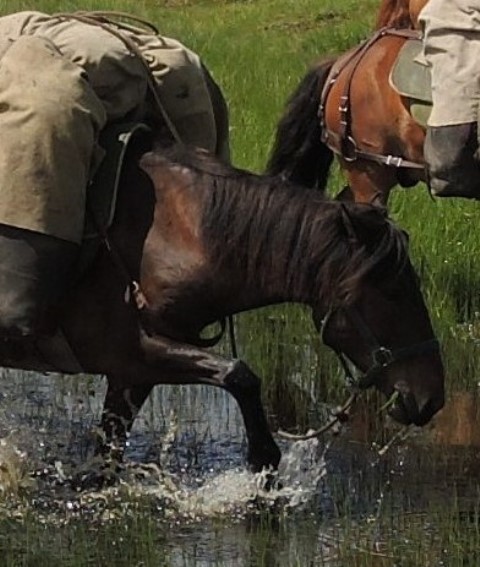
But he is not just a goofy guy; he showed he’s smart and caring when he went after another pack horse (whose name we don’t want to mention here) that lost his footing and got swept downstream a bit; there was Big Dirty Face, going out there and leading the colleague in trouble to calm waters and ashore. It was really heartwarming to see him do that, and re-enforcing our respect for each and every one of our horses.
Mongolian Grulla Horses – Athletes and Expedition Veterans with Stone Horse
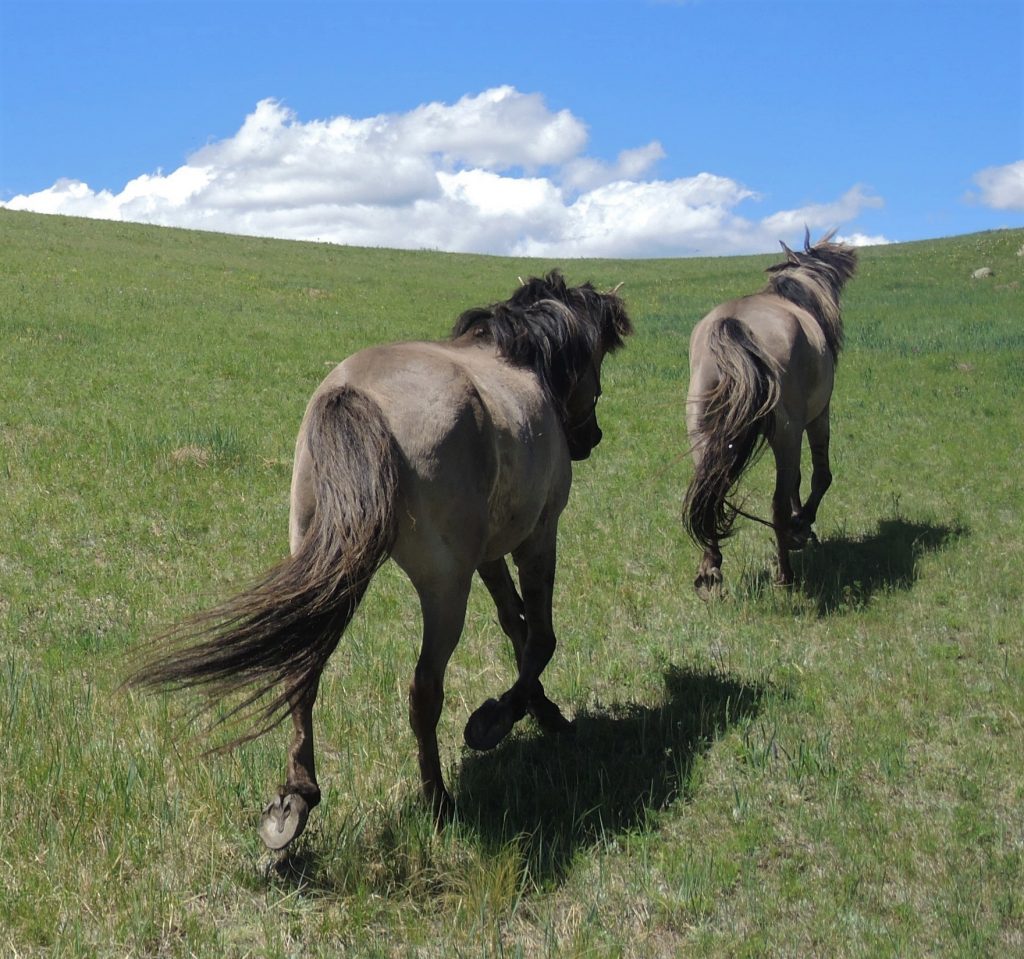
“The Greys – “Good Boy and Little Brother”. To anybody who has seen our two grullas, great looking guys with black dorsal stripes and “zebra stripes” on their legs, it’s obvious how close these two brothers are. “Little Brother”, actually the older one, is of slightly slimmer built than “Good Boy”.
“Little Brother” and “Good Boy” are the long time saddle horses of Keith and myself (Sabine). They have taken us deep into the Khentii wilderness and to all the destinations over the decade of explorations in the Khentii mountains and in Gorkhi Terelj National Park that preceded the establishment of Stone Horse Expeditions in 2010.
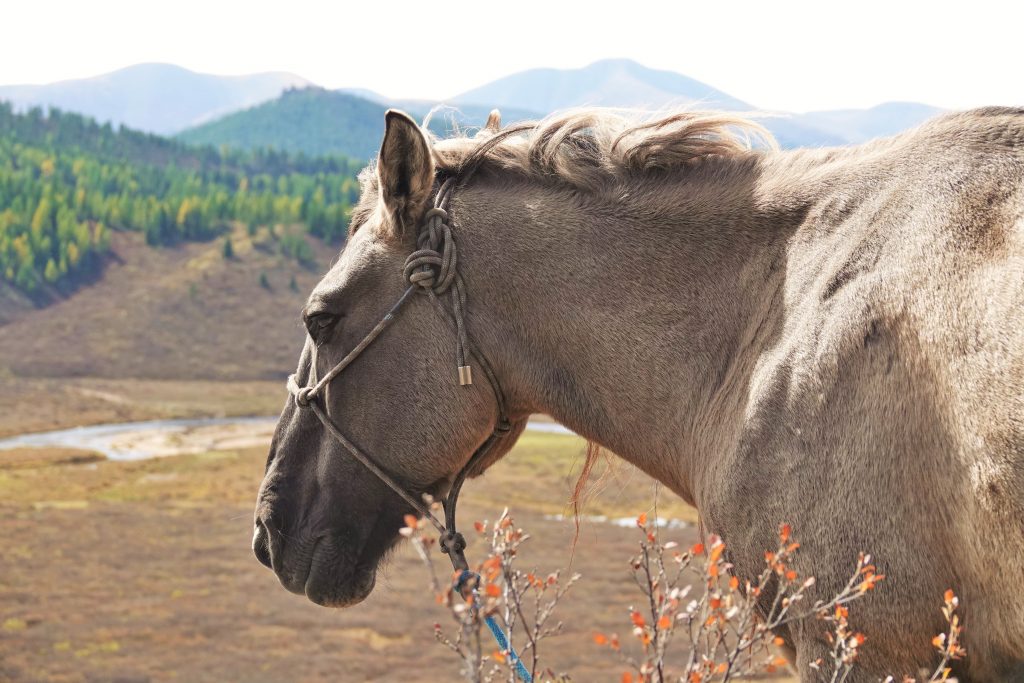
They know the back country as well, or better, than we. They were borne on the steppes of the Southern reaches of Khentii province, and have become great assets for our expeditions. Having spent all their lives together, they were inseparable and did everything together whenever they could in their younger days – grazing, drinking, rolling, peeing – and spooking sometimes.They have become more mature about being separated, but whenever they can, they run together, they call to each other a lot, and they always look out for each other.
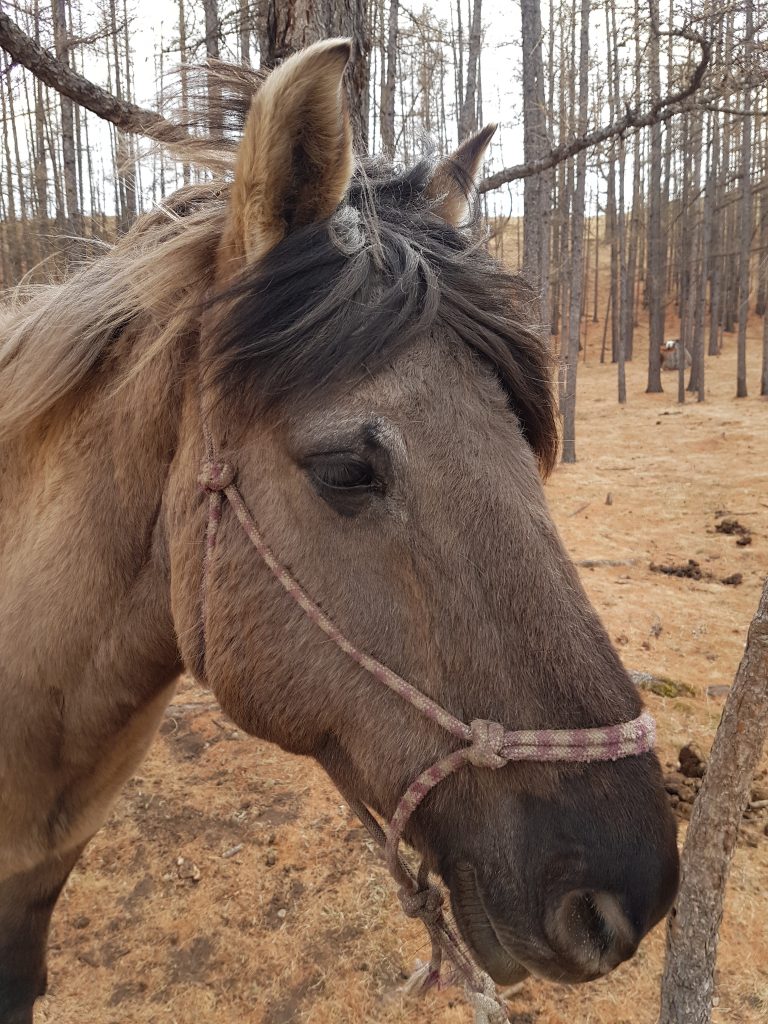
The old greys were a bit more spirited than most of the herd, although mellowed a lot over time. We know it, and appreciate it – after all they have to be ever vigilant, they do live in wolf country. They like to trot, which they do very smoothly, and they can keep it up for hours on end…
Aging gracefully, they are still going strong and they are still the go-to guys when it comes to remembering details of the routes, camp sites and rest stops. They know their worth and their experience, and so do we. They are Stone Horse history and we have a lot of respect for them.
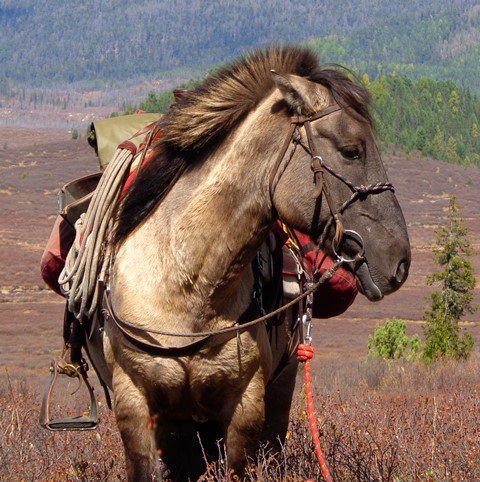 “Little Big Man” – The Young Grey looks a lot like the two older greys – except better! and he knows it. He is really graceful when he moves along, and move he can! But being fast and strong and young doesn’t mean he is not very responsive and gentle. He is a smart one, too. He is the one who watches us opening the gate and then tries himself. He is also a bit of a prankster. On winter mornings, when he has finished his bowl of oats, he picks up the bowl and throws it somewhere, before he proceeds to get to other’s oats. He is a great riding horse with a very easy going and willing character for the rider he carries. To younger and newer members in the herd he can be a bit of a bully though. Little Big Man is from the Darkhid Valley, just up the road from our staging area. He is one of the tallest of the Stone Horses..
“Little Big Man” – The Young Grey looks a lot like the two older greys – except better! and he knows it. He is really graceful when he moves along, and move he can! But being fast and strong and young doesn’t mean he is not very responsive and gentle. He is a smart one, too. He is the one who watches us opening the gate and then tries himself. He is also a bit of a prankster. On winter mornings, when he has finished his bowl of oats, he picks up the bowl and throws it somewhere, before he proceeds to get to other’s oats. He is a great riding horse with a very easy going and willing character for the rider he carries. To younger and newer members in the herd he can be a bit of a bully though. Little Big Man is from the Darkhid Valley, just up the road from our staging area. He is one of the tallest of the Stone Horses..
“Little Star” joint the herd in 2017, arriving from Mongolia’s Sukhbaatar province, famed for horse breeding. He is a 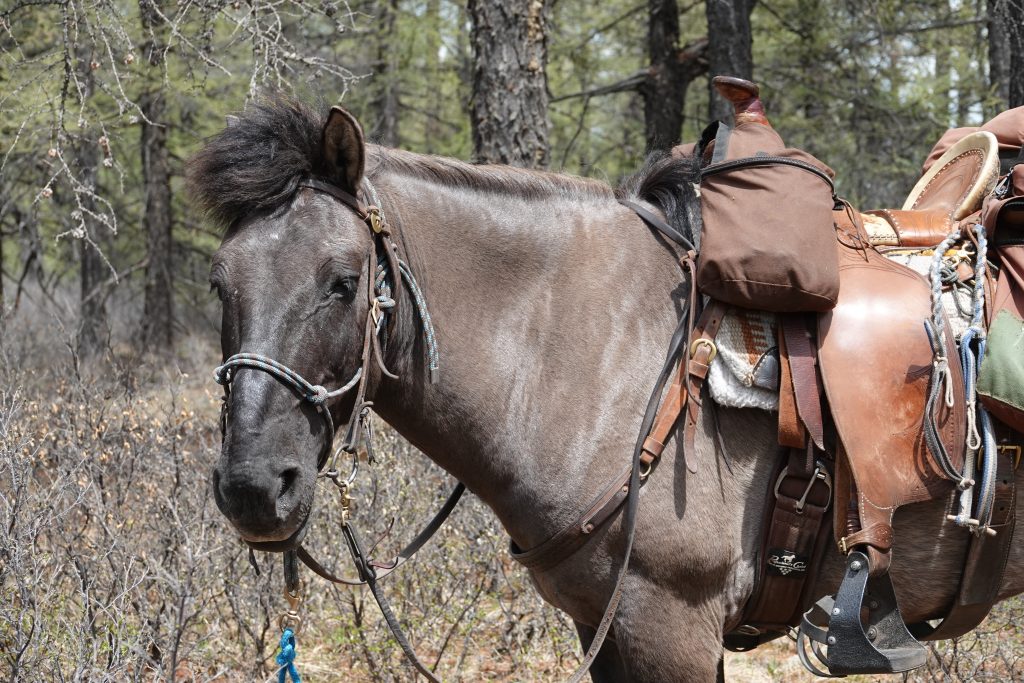 grulla, too, though not as tall as our other greys. But he has a very fast trot, smooth and with a long stride. His strength shows in the open grasslands where he grew up. I asked him to join and help so that Good Boy wouldn’t have to be under saddle day after day, on back to back horse treks. So now he is taking turns with Good Boy, and he covers the long days in open country. He has also become familiar with the forests which he hadn’t traveled in where he grew up. He remains very cautious though, and makes little jumps to avoid the many, imagined threats. He is a nice character, and when we get ahead, as the trip leaders… he wants to stop and wait for everybody..
grulla, too, though not as tall as our other greys. But he has a very fast trot, smooth and with a long stride. His strength shows in the open grasslands where he grew up. I asked him to join and help so that Good Boy wouldn’t have to be under saddle day after day, on back to back horse treks. So now he is taking turns with Good Boy, and he covers the long days in open country. He has also become familiar with the forests which he hadn’t traveled in where he grew up. He remains very cautious though, and makes little jumps to avoid the many, imagined threats. He is a nice character, and when we get ahead, as the trip leaders… he wants to stop and wait for everybody..
He really likes grass, both for eating, of course, and for running on. He is careful on rocks, and when we ford rivers on his day off, he will wait and watch everybody cross, and then pick his route. Smart. The fact that he fairly easy integrated into the herd also shows he must be smart, navigating bullies and making friends and allies. Him and Little Big Man got along right away, they are similar in age. He always seems to take a keen interest in everything that’s going on around him, watching every detail when he is being saddled.
On the days when we take a ride into the hills from out tented camp, he gets very excited and competitive. He is strong and fast, a little powerhouse, and once he is in the racing spirit, he wants to keep it up. He has a distinct Roman nose too, like Good Boy. His forehead has a tiny white star – hence his name. After a rainy night, he tends to be in a bad mood, initially, but as soon as saddled he is fine and keen.
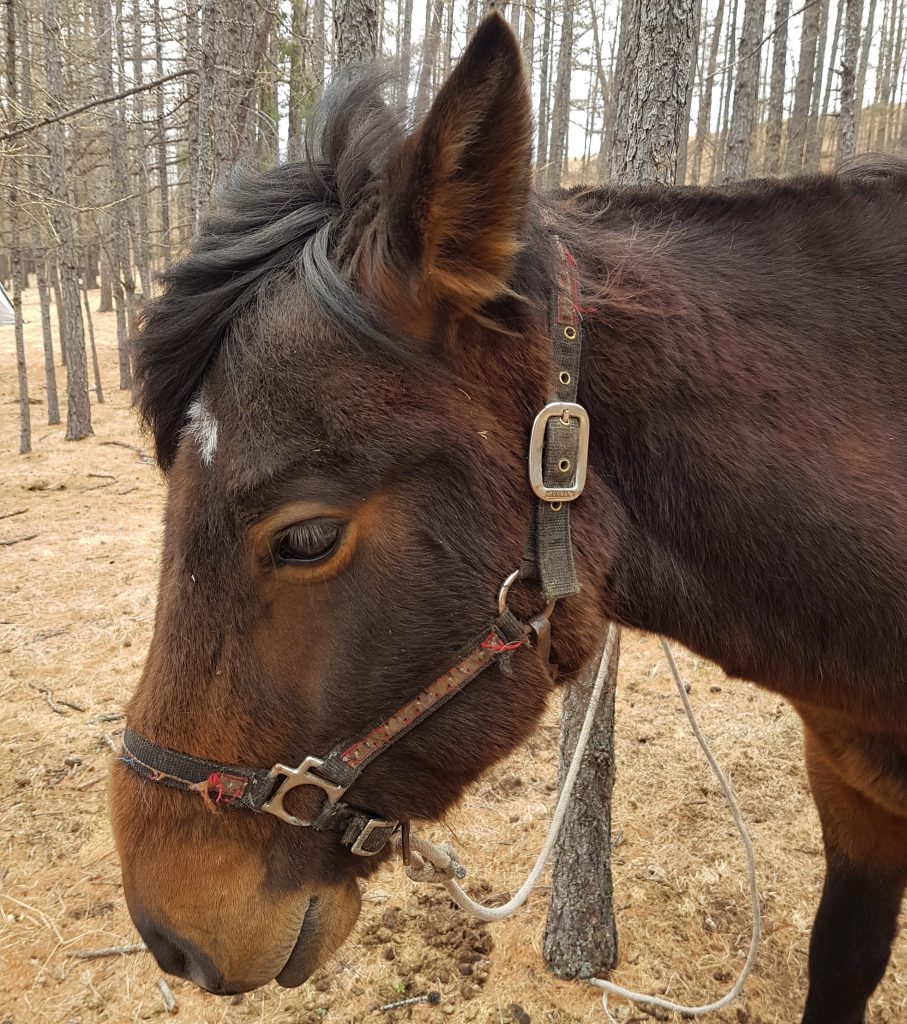
“Sartai Haltar” and “Haltar” Mor, are the two tall pack horses that are on most treks nowadays. They are part of the “gang of five” along with New Brownie, a Big Red Roan and Little/New Blackie that joined Stone Horse after a trek of several months from Central to Northern Mongolia. “Haltar” is that tone of uneven brown, like the “Dirty Faces”. “Sartai” means “with moon” – “Sartai Haltar” has a little moon on his forehead.
They both like to be rather in the front of the pack horse team, and keep that constant commotion going among the pack team members vying for a leading position. (Ben used to participate in that quite a bit too, but doesn’t seem to care so much anymore.)
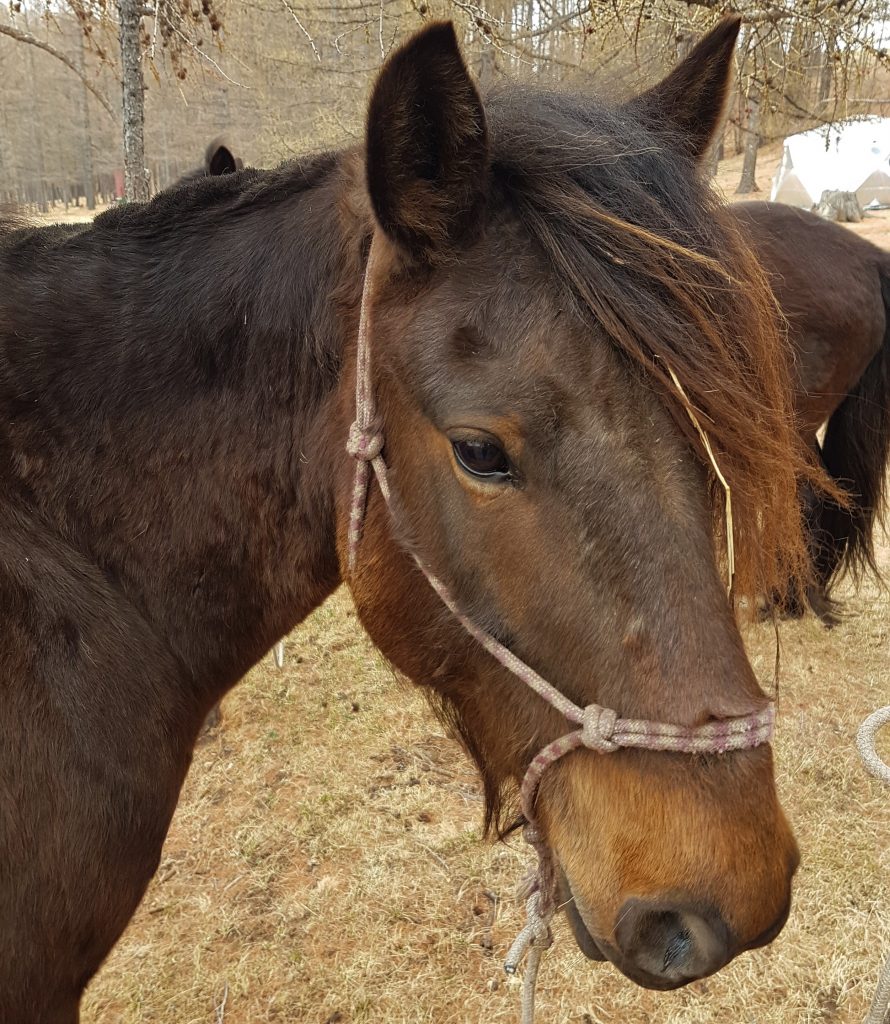
Haltar pack horse can be a little irritated if there is a slight rattling in his pack or a strap comes loose, causing him to run in circles for a bit while his team mates look on, shaking their heads.. He also likes to nip “Little Star” in the butt. Whenever I am riding Little Star, and he suddenly shoots forward, I know who is behind us. Both Haltar horses have become recognized team members and do a good job carrying packs.
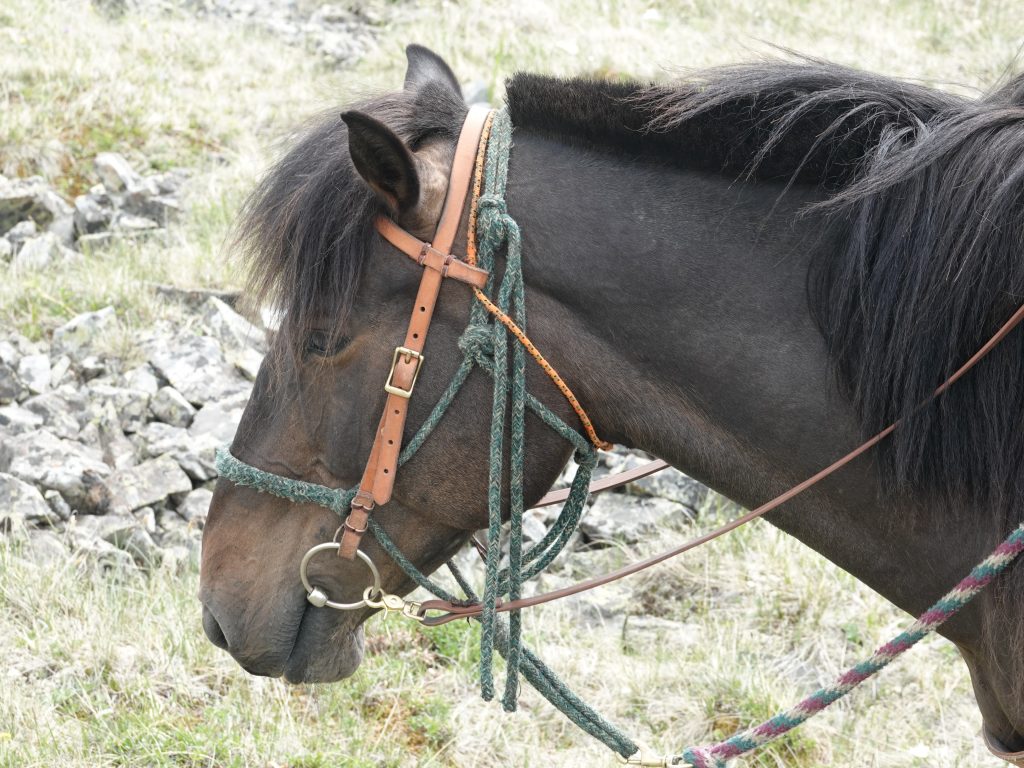 “Little Blackie”, (or “New Blackie”), joined in 2015 with the other 4 trekking horses. He has a great gait and riders with a bit of confidence and assertiveness enjoy him a lot under saddle. He is another horse who is very observant of ANYTHING an equine could consider unusual on or near the trail, and he likes a rider reassuring him that all is ok and there’s no reason to jump. He’s easily handled just needs that reassurance. He is one of the smaller team mates, but fast and strong nevertheless, and has given many riding guests joy on the trail, and sometimes bare back rides in camp or in the lake. He remains closely attached to his four comrades, and when left without them, he calls for them. He has a mighty voice for a little horse.
“Little Blackie”, (or “New Blackie”), joined in 2015 with the other 4 trekking horses. He has a great gait and riders with a bit of confidence and assertiveness enjoy him a lot under saddle. He is another horse who is very observant of ANYTHING an equine could consider unusual on or near the trail, and he likes a rider reassuring him that all is ok and there’s no reason to jump. He’s easily handled just needs that reassurance. He is one of the smaller team mates, but fast and strong nevertheless, and has given many riding guests joy on the trail, and sometimes bare back rides in camp or in the lake. He remains closely attached to his four comrades, and when left without them, he calls for them. He has a mighty voice for a little horse.
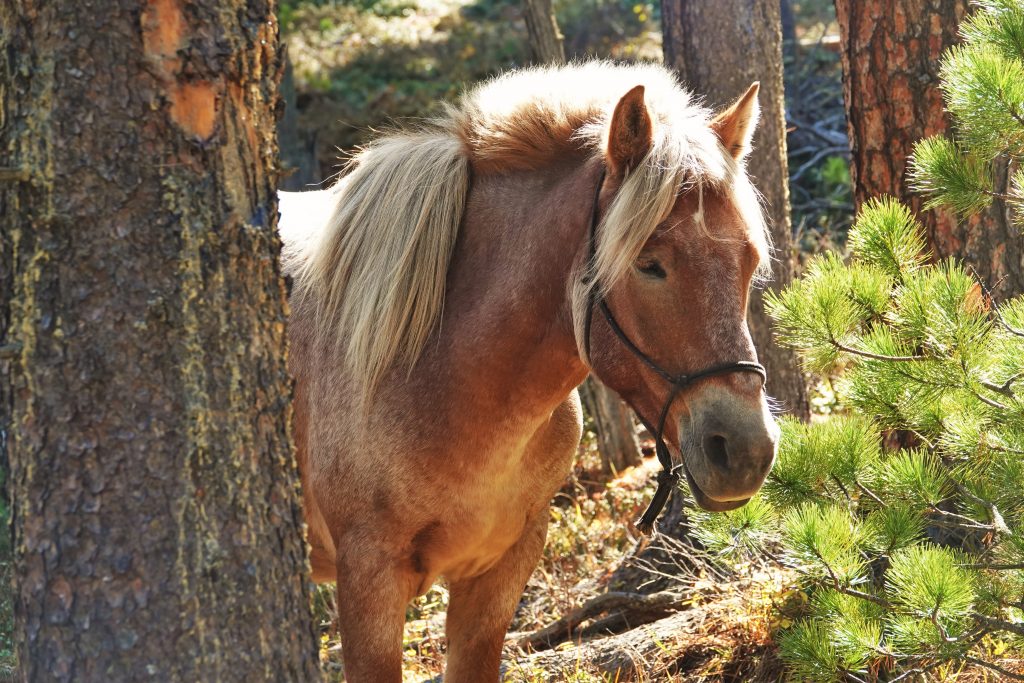 “Big Roan” is one of the biggest horses among the Stone Horse equine crew. He came with Little Blackie and the other three. He is strong and a good workhorse. He can make unusual choices and unexpected high jumps on the trail though, and therefore he is best matched with one of our young horsemen who can relate and respond to that kind of behavior, in fact enjoys it. The Roan has done a lot of work for our expeditions, and we appreciate that. He otherwise keeps a low profile as a herd member. And he looks great with a good haircut and as the sunlight filters through the forest canopy.
“Big Roan” is one of the biggest horses among the Stone Horse equine crew. He came with Little Blackie and the other three. He is strong and a good workhorse. He can make unusual choices and unexpected high jumps on the trail though, and therefore he is best matched with one of our young horsemen who can relate and respond to that kind of behavior, in fact enjoys it. The Roan has done a lot of work for our expeditions, and we appreciate that. He otherwise keeps a low profile as a herd member. And he looks great with a good haircut and as the sunlight filters through the forest canopy.
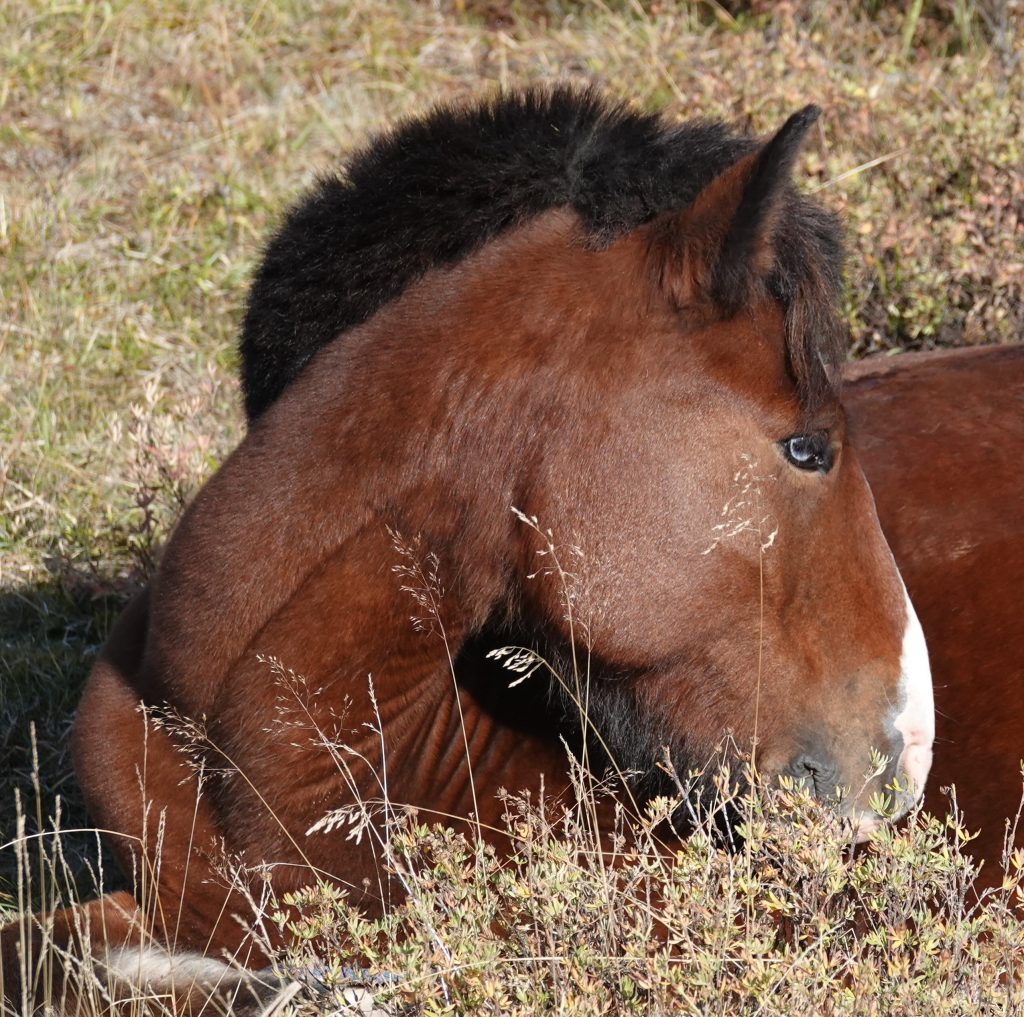 “Blue Eyes” – its easy to see how he got his name. He is our only blue-eyed horse. Him and “New Tseerd” became Stone Horse members in 2019. And from their first trips on, they became favorites of guest riders! They are both of great conformation, a good size, athletic and with a nice gait. And very responsive and cooperative, a true joy to handle and ride. Keith went out to find good horses to join our equine team, with veterinarian Boldoo who knows a lot of good horsemen and breeders in the country side. And these two horses come from exactly such family – true nomads and horsemen who bring up healthy horses and prepare them really well as riding horses. Blue Eyes and New Tseerd are a very valuable addition to our saddle horses for riding guests. Any rider, whether beginner or advanced, willl enjoy them as their trail hors
“Blue Eyes” – its easy to see how he got his name. He is our only blue-eyed horse. Him and “New Tseerd” became Stone Horse members in 2019. And from their first trips on, they became favorites of guest riders! They are both of great conformation, a good size, athletic and with a nice gait. And very responsive and cooperative, a true joy to handle and ride. Keith went out to find good horses to join our equine team, with veterinarian Boldoo who knows a lot of good horsemen and breeders in the country side. And these two horses come from exactly such family – true nomads and horsemen who bring up healthy horses and prepare them really well as riding horses. Blue Eyes and New Tseerd are a very valuable addition to our saddle horses for riding guests. Any rider, whether beginner or advanced, willl enjoy them as their trail hors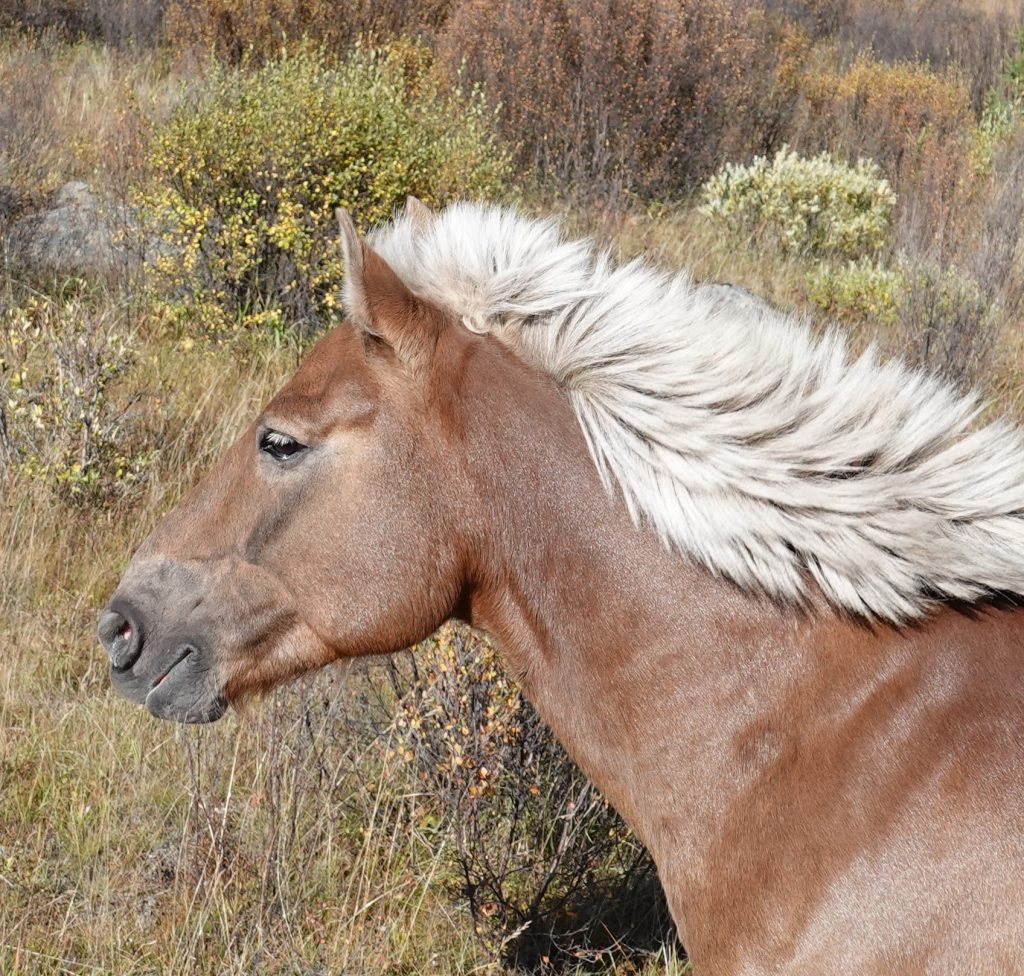 e.
e.
Coming from another herd, they are still a little separate. Especially Blue Eyes, he is a rather gentle character and he doesn’t defend himself much or stands up for his food ration in the winter. So we have been keeping an eye on him to make sure he gets his feed. It might take a bit longer with him, but he will make himself a full member of the Stone Horses at his own pace.
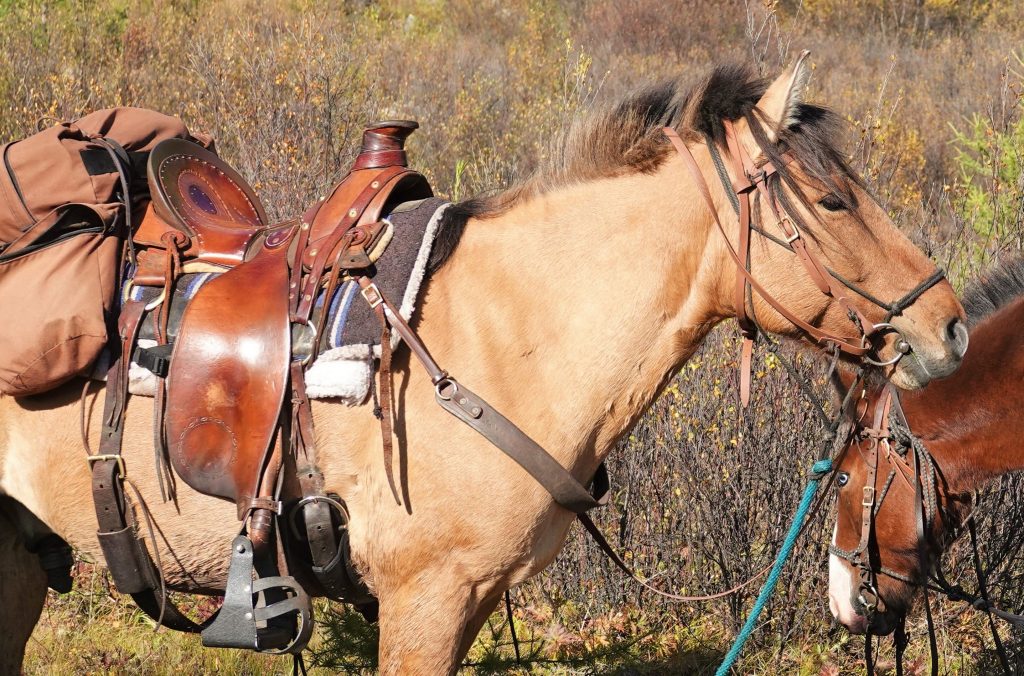 “Little Khul” (Little Bay) is the youngest team member and he has been taking part in Stone Horse Expeditions since 2018, when he had turned six. He grew up in the valley hanging out with old Fish and the old Roan, and learnt from them about life as a horse, and perhaps about being an expedition horse. He was keen to start and did a good job from the beginning. He likes to have a good rider who lets him know clearly what is expected from him. He is responsive, yet quite forward going, and strong, and getting stronger. He sticks with the herd, and doesn’t need to be hobbled. When his saddle cinch is tightened he acts surprised and sometimes tries to nip at the person fixing his saddle.
“Little Khul” (Little Bay) is the youngest team member and he has been taking part in Stone Horse Expeditions since 2018, when he had turned six. He grew up in the valley hanging out with old Fish and the old Roan, and learnt from them about life as a horse, and perhaps about being an expedition horse. He was keen to start and did a good job from the beginning. He likes to have a good rider who lets him know clearly what is expected from him. He is responsive, yet quite forward going, and strong, and getting stronger. He sticks with the herd, and doesn’t need to be hobbled. When his saddle cinch is tightened he acts surprised and sometimes tries to nip at the person fixing his saddle.
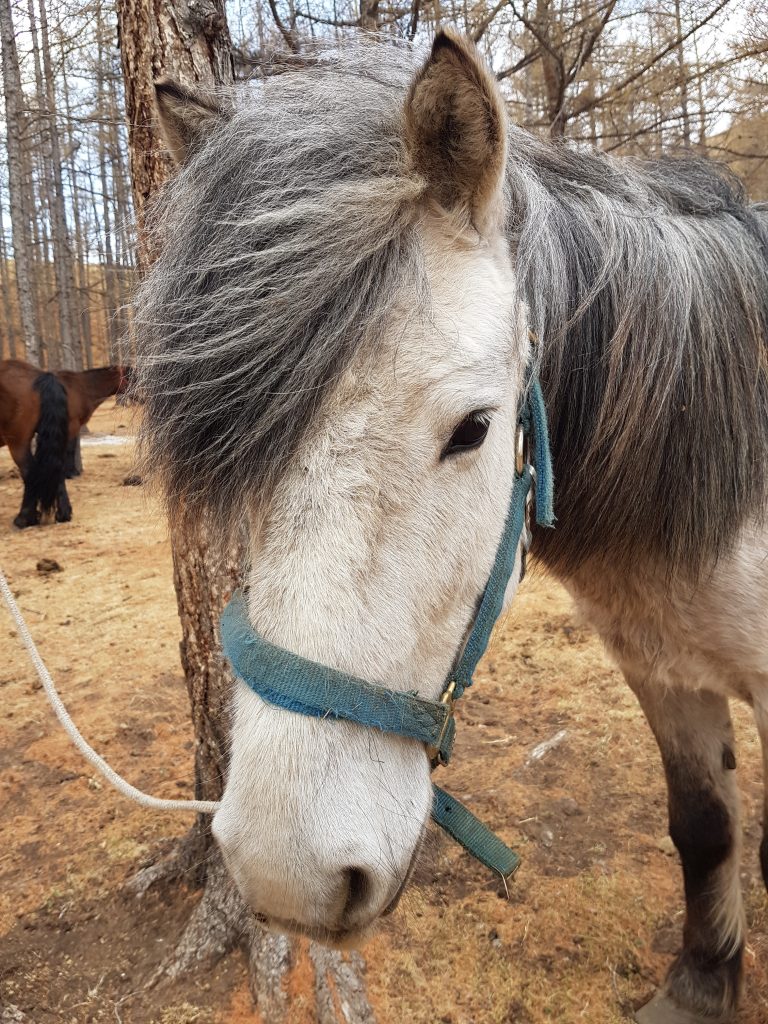
Little Khongor and Little Buraal. These two little horses arrived in the valley from the Khangai area in central Mongolia in early summer of 2019. And little they were. After a couple of months of doing nothing but graze they had grown quite a bit, not really taller, but round and strong. So they came on their first trips, just to get used to it and learn the routine.
They both learnt on the job, practicing being a pack horse one day in camp while the riders were out for the day. They both picked up the skills of carrying a pack quickly, and started carrying loads. Smaller loads, according to their size, like a few sleeping bags and mats at first. Our horsemen also had a lot of fun riding Little Buural, he really wants to run, both under saddle and with a pack. Of course, they were chased a bit by other equine team members, which send them forward. But one did have the impression that they both wanted to show they can do this, despite being short guys! They were fearless, plunging themselves into the river to cross the currents that reached to their bellies.
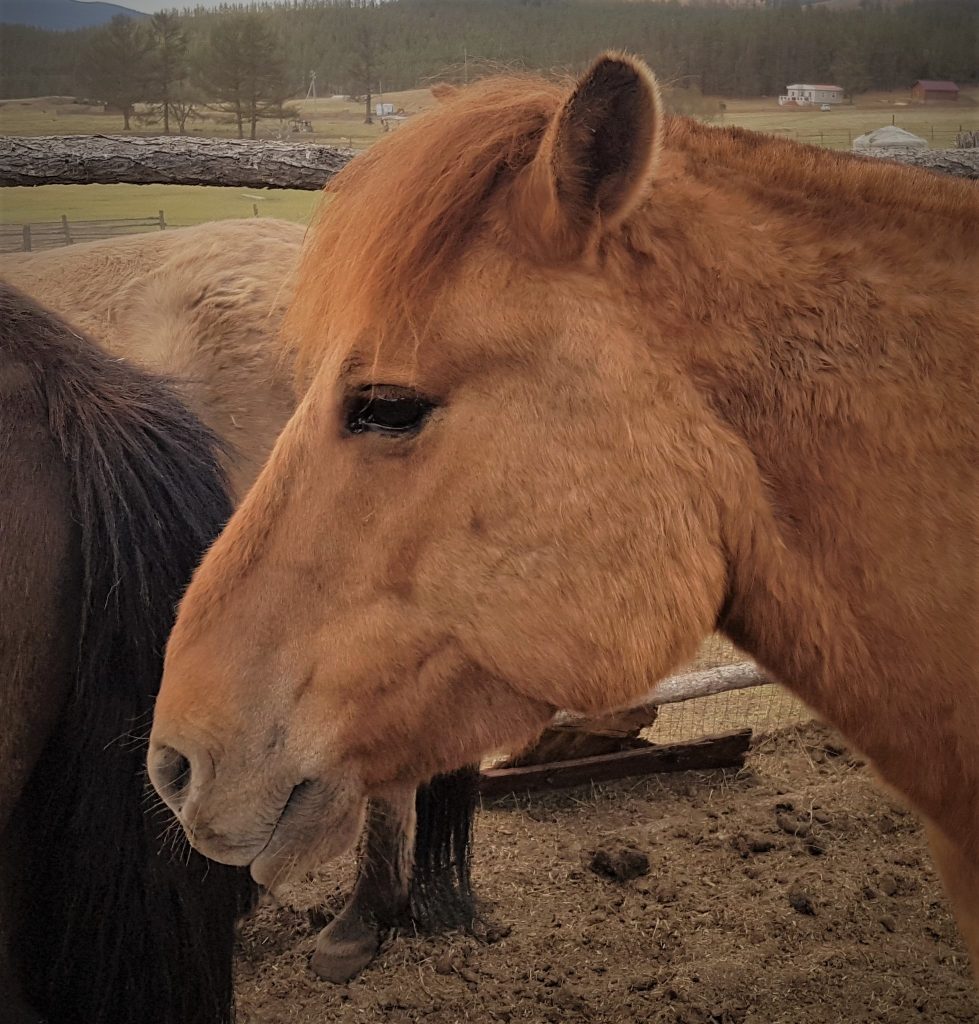
During their first winter in the corral with the herd, they had to stand their ground, and it helped being a bit feisty. We still served them their oats in a special section, where all the new horses had their meals to make sure they get their winter feed. They have earned the respect of the other horses and definitely of us, and are now Stone Horses with a job, and benefits.
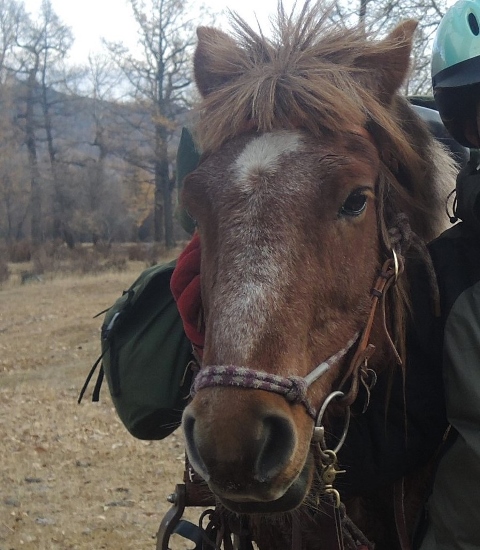 “The Old Roan” is fully retired now; he may still do a job for a couple hours to take home stay guests for a ride around the valley. He has been a reliable and calm trail horse for many years, in the early years of Stone Horse Expeditions and way before that. Home in the Darkhid Valley, he hangs out with Fish and looks after him. He calls out to Fish,when its time to move on or he goes and gets him when Fish hasn’t noticed they are moving on. Fish is blind on one eye. Both of them enjoy special privileges, namely in winter, with advanced access to hay. They spend nights together and their own corral where they also get served their bran mash.
“The Old Roan” is fully retired now; he may still do a job for a couple hours to take home stay guests for a ride around the valley. He has been a reliable and calm trail horse for many years, in the early years of Stone Horse Expeditions and way before that. Home in the Darkhid Valley, he hangs out with Fish and looks after him. He calls out to Fish,when its time to move on or he goes and gets him when Fish hasn’t noticed they are moving on. Fish is blind on one eye. Both of them enjoy special privileges, namely in winter, with advanced access to hay. They spend nights together and their own corral where they also get served their bran mash.
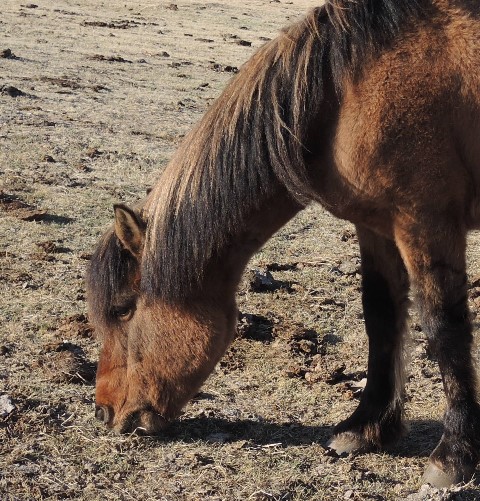 “Fish” is last, but NOT least at all, on our list here. He is the most senior and experienced of them all. He is about 33 years old. He was my first saddle horse in Mongolia and he taught me a lot. He also showed our greys, still young boys back then, how to cross rivers in the wilderness and he was the one who know all the trails by heart. He is a small horse, but he was strong in his days, and willingly served as a riding and pack horse – though he preferred a rider instead of a pack. Fish got his name from the brand that is reminiscent of a fish symbol.
“Fish” is last, but NOT least at all, on our list here. He is the most senior and experienced of them all. He is about 33 years old. He was my first saddle horse in Mongolia and he taught me a lot. He also showed our greys, still young boys back then, how to cross rivers in the wilderness and he was the one who know all the trails by heart. He is a small horse, but he was strong in his days, and willingly served as a riding and pack horse – though he preferred a rider instead of a pack. Fish got his name from the brand that is reminiscent of a fish symbol.
Fish has carried many riders, and more important probably, has given them confidence in horse riding and even a new outlook on life. He has always been very good with kids; with the very young, inexperienced and the timid, he perfectly adjusted his gait and manners. We called him a Medicine Horse. He totally tuned into the needs of his riders; he was a teacher, healer and is a great little horse to whom I am forever grateful. He has a few scars, from three wolf attacks that he survived. Because he did like to take naps – we’ve watched him fall asleep while the grazing herd slowly moved on; he would wake up, find himself alone and quickly catch up with his, mostly taller, team members.
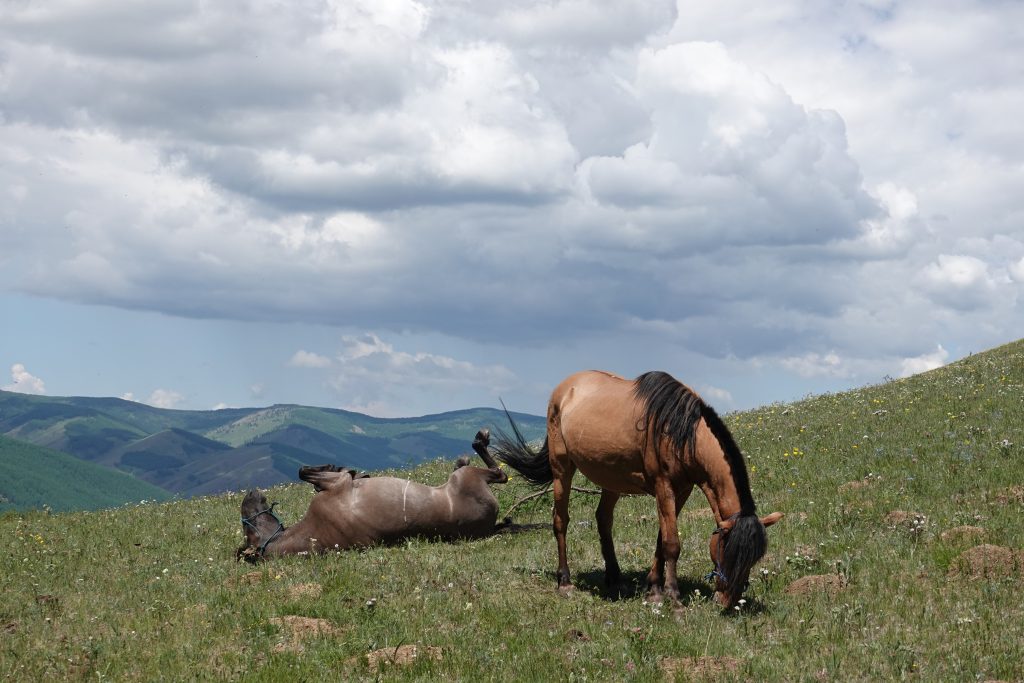
Get to know these great horses for riding holidays in Mongolia! Traveling into the wilderness with a team of saddle and pack horses is a very special experience, much more than just riding a horse. Learn more about equine behavior, and enter the wilderness with these trusted companions.
Gorkhi Terelj National Park 10 Day Riding Tour
Autumn Horse Trek in Gorkhi Terelj National Park, 8 Days
Khentii Mountains Expedition 14 Days
Wilderness Conservation Adventure 14 Days



